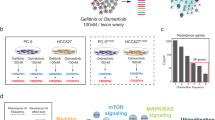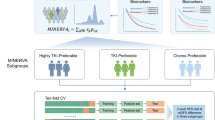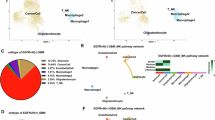Abstract
Previous studies have shown a correlation between expression of the EGF receptor type III mutation (EGFRvIII) and a more malignant phenotype of various cancers including: non-small-cell lung cancer, glioblastoma multiforme, prostate cancer and breast cancer. Thus, a detailed molecular genetic understanding of how the EGFRvIII contributes to the malignant phenotype is of major importance for future therapy. The GeneChip Hu6800Set developed by Affymetrix was used to identify changes in gene expression caused by the expression of EGFRvIII. The cell line selected for the study was an EGF receptor negative small-cell-lung cancer cell line, GLC3, stably transfected with the EGFRvIII gene in a Tet-On system. By comparison of mRNA levels in EGFRvIII-GLC3 with those of Tet-On-GLC3, it was found that the levels of mRNAs encoding several transcription factors (ATF-3, JunD, and c-Myb), cell adhesion molecules (CD36, CD24), signal transduction related molecules (MKP-1) and other molecules related to cancer (CD98, thymosin beta-10) were altered in the EGFRvIII transfected cell line. Northern hybridisations and Western blot analyses were used to verify selected results. The results indicate that expression of EGFRvIII alters expression of genes involved in the control of cell growth, survival and motility. © 2001 Cancer Research Campaign http://www.bjcancer.com
Similar content being viewed by others
Article PDF
Change history
16 November 2011
This paper was modified 12 months after initial publication to switch to Creative Commons licence terms, as noted at publication
References
Antonyak MA, Moscatello DK and Wong AJ (1998) Constitutive activation of c-Jun N-terminal kinase by a mutant epidermal growth factor receptor. J Biol Chem 273: 2817–2822
Batra SK, Castelino-Prabhu S, Wikstrand CJ, Zhu X, Humphrey PA, Friedman HS and Bigner DD (1995) Epidermal growth factor ligand-independent, unregulated, cell-transforming potential of a naturally occurring human mutant EGFRvIII gene. Cell Growth Differ 6: 1251–1259
Brinckerhoff CE, Rutter JL and Benbow U (2000) Interstitial collagenases as markers of tumor progression. Clin Cancer Res 6: 4823–4830
Der SD, Zhou A, Williams BR and Silverman RH (1998) Identification of genes differentially regulated by interferon alpha, beta, or gamma using oligonucleotide arrays. Proc Natl Acad Sci USA 95: 15623–15628
Garcia dPI, Adams GP, Sundareshan P, Wong AJ, Testa JR, Bigner DD and Weiner LM (1993) Expression of mutated epidermal growth factor receptor by non-small cell lung carcinomas. Cancer Res 53: 3217–3220
Kaminski N, Allard JD, Pittet JF, Zuo F, Griffiths MJ, Morris D, Huang X, Sheppard D and Heller RA (2000) Global analysis of gene expression in pulmonary fibrosis reveals distinct programs regulating lung inflammation and fibrosis. Proc Natl Acad Sci USA 97: 1778–1783
Lorimer IA and Lavictoire SJ (2001) Activation of extracellular-regulated kinases by normal and mutant EGF receptors. Biochim Biophys Acta 1538: 1–9
Moscatello DK, Holgado-Madruga M, Godwin AK, Ramirez G, Gunn G, Zoltick PW, Biegel JA, Hayes RL and Wong AJ (1995) Frequent expression of a mutant epidermal growth factor receptor in multiple human tumors. Cancer Res 55: 5536–5539
Moscatello DK, Holgado-Madruga M, Emlet DR, Montgomery RB and Wong AJ (1998) Constitutive activation of phosphatidylinositol 3-kinase by a naturally occurring mutant epidermal growth factor receptor. J Biol Chem 273: 200–206
Nagane M, Coufal F, Lin H, Bogler O, Cavenee WK and Huang HJ (1996) A common mutant epidermal growth factor receptor confers enhanced tumorigenicity on human glioblastoma cells by increasing proliferation and reducing apoptosis. Cancer Res 56: 5079–5086
Nagane M, Levitzki A, Gazit A, Cavenee WK and Huang HJ (1998) Drug resistance of human glioblastoma cells conferred by a tumor-specific mutant epidermal growth factor receptor through modulation of Bcl-XL and caspase-3-like proteases. Proc Natl Acad Sci USA 95: 5724–5729
Nishikawa R, Ji XD, Harmon RC, Lazar CS, Gill GN, Cavenee WK and Huang HJ (1994) A mutant epidermal growth factor receptor common in human glioma confers enhanced tumorigenicity. Proc Natl Acad Sci USA 91: 7727–7731
Olapade-Olaopa EO, Moscatello DK, MacKay EH, Horsburgh T, Sandhu DP, Terry TR, Wong AJ and Habib FK (2000) Evidence for the differential expression of a variant EGF receptor protein in human prostate cancer. Br J Cancer 82: 186–194
Prigent SA and Lemoine NR (1992) The type 1 (EGFR-related) family of growth factor receptors and their ligands. Prog Growth Factor Res 4: 1–24
Sugawa N, Yamamoto K, Ueda S, Morita N, Kita M, Nishino H, Fushiki S and Okabe T (1998) Function of aberrant EGFR in malignant gliomas. Brain Tumor Pathol 15: 53–57
Author information
Authors and Affiliations
Corresponding author
Additional information
Supported by the Danish Cancer Society and the Danish Research Council
Epidermal Growth Factor Receptor Mutation Type III Transfected Into a Small Cell Lung Cancer Cell Line Is Predominantly Localized at the Cell Surface and Enhance the Malignant Phenotype. Damstrup L, Pedersen MW, Bastholm L, Elling F, Poulsen HS (submitted)
Rights and permissions
From twelve months after its original publication, this work is licensed under the Creative Commons Attribution-NonCommercial-Share Alike 3.0 Unported License. To view a copy of this license, visit http://creativecommons.org/licenses/by-nc-sa/3.0/
About this article
Cite this article
Pedersen, M., Thykjær, T., Ørntoft, T. et al. Profile of differentially expressed genes mediated by the type III epidermal growth factor receptor mutation expressed in a small-cell lung cancer cell line. Br J Cancer 85, 1211–1218 (2001). https://doi.org/10.1054/bjoc.2001.2053
Received:
Revised:
Accepted:
Published:
Issue date:
DOI: https://doi.org/10.1054/bjoc.2001.2053
Keywords
This article is cited by
-
Identification of common signatures in idiopathic pulmonary fibrosis and lung cancer using gene expression modeling
BMC Cancer (2020)
-
A novel epidermal growth factor receptor variant lacking multiple domains directly activates transcription and is overexpressed in tumors
Oncogene (2012)
-
CD24 interacts with and promotes the activity of c-src within lipid rafts in breast cancer cells, thereby increasing integrin-dependent adhesion
Cellular and Molecular Life Sciences (2012)
-
Hypomethylation of the Thymosin β10 Gene Is Not Associated with Its Overexpression in Non-Small Cell Lung Cancer
Molecules and Cells (2011)



